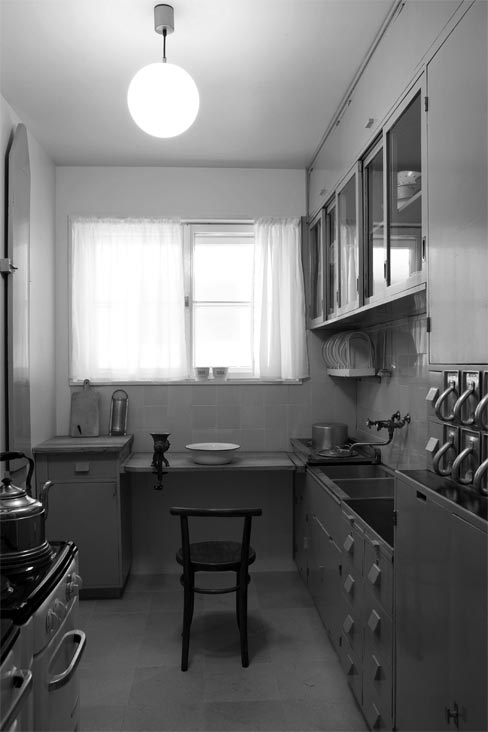Exhibit Review
Modernism: Designing a New World, 1914-1939
Corcoran Gallery of Art, Washington, DC; Curator: Victoria and Albert Museum; Designer: Eva Jiricna
March 17-July 29, 2007
Modernism: Designing a New World, 1914-1939, on display at the Corcoran Gallery of Art in Washington, DC, is a vast exhibition with more than 400 works and 50 film clips representative of the avant-garde art movements that both challenged and shaped contemporary culture during the first half of the 20th century. Originally organized by the Victoria and Albert Museum in London, the show is impressive in terms of the number and range of its contents that include works in a variety of media, objects of various dimensions, machines, and installations. Items on display include iconic pieces such as Ukrainian painter and architect Vladimir Tatlin's model of a Monument to the Third International (1920) and Hungarian-born architect and furniture designer Marcel Breuer's Club Chair (1925); as well as more rarely exhibited pieces such as Italian painter Giacomo Balla's Futurist Suit from the 1920s and video clips and costumes for German designer Oskar Schlemmer's Triadic Ballet.
Modernism points out how much the art movements that emerged between 1914 and 1939 influenced contemporary life. It attempts to show the many radical ideas and important historical events behind the search for a new aesthetic to challenge the prevailing European art establishment. That aesthetic involved a rejection of ornamentation, preference for abstraction, use of pure geometry, and affinity for bold colors that characterize the work of such well-known and influential movements as Cubism, De Stijl, the Bauhaus, and Purism.
Influenced by revolutionary technological developments (the electric light bulb, the automobile, the airplane, radio and telephone communication) and the social, economic, and political tensions of the interwar period in Europe, many designers believed that the world was at the start of a new era and that their work might transform human life. Propelled by a desire for social progress, aided by the power and efficiency of science and technology, and guided by their imaginations, modernist artists, architects, and other designers saw no limits to how their art could help bring about a global transformation.
A superb illustration of this modernist vision is the Austrian architect Grete Lihotzky's 1926 design for a modern fitted kitchen for a public housing project in Frankfurt, Germany. Known as the Frankfurt Kitchen, Lihotzky's room featured energy efficient appliances and built-in cabinets to eliminate wasted space. The architect applied scientific principles to improve hygiene and manage waste disposal, and, using time-motion data, arranged the furniture and appliances to reduce the amount of time and effort required to prepare a meal. Efficient home kitchen designs today use the "work triangle" concept applied by Lihotzky in the layout of the Frankfurt kitchen.
 |
The Modernism exhibit includes Grete Lihotzky’s Frankfurt kitchen from the Am Höhenblick housing estate, Ginnheim, Frankfurt, Germany. (Courtesy of the Victoria and Albert Museum, London.) |
From city plans to kitchen utensils, Modernism shows the full range of design innovation and production of the interwar period. The show itself is organized around the themes of "Utopia," "The Machine and Mass Production," "Nature and the Healthy Body," and "National Modernism and Identity." It also examines the beginnings of Modernism through its evolution into a mass movement. A considerable portion of the show focuses on the influence of Modernism in the United States. Many influential figures such as Marcel Duchamp, Piet Mondrian, Ludwig Mies van der Rohe, Walter Gropius, and Marcel Breuer, fled to the United States in search of artistic freedom or to escape political persecution.
Many European émigrés quickly became part of the American design establishment. The German architects Mies van der Rohe and Gropius, for example, became the heads of prestigious schools of design in the United States (the Illinois Institute of Technology and Harvard University respectively). Their renown and influence were in large part responsible for the absorption of Modernism's formal design qualities into the American mainstream. As modern design became part of everyday life, its original theoretical underpinnings receded into the background. Whether these circumstances contributed to Modernism's end as the show suggests is a subject of continued debate.
A weak point of the exhibition is the almost complete neglect of the impact of Modernism beyond Europe and America. Modernist design had—and continues to have—a tremendous impact across the globe, particularly in developing countries where modern design symbolized modernity and progress. Brazil and other countries invested a tremendous amount of resources into planning and building a new capital, Brasilia, according to modernist principles. This and other large-scale projects of the postwar era have generated both praise and controversy. While many of these projects postdate the period covered by the show, some treatment of this topic would have strengthened the exhibit.
If the current appreciation for Modernism's clean lines and bold forms are any indicator, then the style (if not necessarily the rhetoric) is back in fashion in everything from architecture and high-end furniture to mass-produced housewares. Its renewed popularity is a testament to the strength of the early modernist oeuvre and the optimism it embodied. One might say, too, that its popularity today is due to the inability of any other recent design movement to attract and sustain consumer attention. In either case, the renewed enthusiasm for Modernism (the aesthetic) has resulted in impressive attendance figures for Modernism (the exhibit) in London. The show is likewise meeting the Corcoran's estimates for a projected attendance of 100,000 by the end of July.
Antonio Aguilar
Technical Preservation Services
National Park Service
